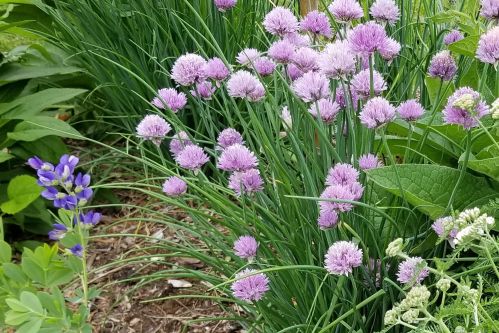Resources
Companion Planting vs Grass Around Fruit Trees
Apple trees and grass are not exactly good companion plants.
We are often asked how wide a mulch ring is around any given fruit tree. This can be a specious argument, depending on who you ask. But let's just suppose for a moment, that you could fast forward time about five years after you've planted your first apple tree. Let's also suppose that you've also planted chives around that tree.
CHIVES
Well let's just assume that the variety of apples you wanted is more susceptible to apple scab; chives can take care of that. Chives not only are added to many dishes in the kitchen but are also used as nature's pest confusers. Plant these around the trunk of the tree.
DAFFODIL
These also get planted in a ring around the tree. Not only are they among the first blossoms in the spring, but are a rodent deterrent, keeping the rodents from chewing the bark off. Plus flowers to bring in for the dining table.
CURRANTS
All black, white, or red currants are beneficial below the tree. They each offer medicinal and culinary uses.
STRAWBERRY
Another plant that is not only good to eat but draws in beneficial insects. The canopy of the tree provides less sunlight, the strawberry will spread out as the tree grows, on its own, or with your help to get out from underneath the tree canopy to get more sunlight.
LEMON BALM
Another plant used for stabilizing soil, drawing in beneficial insects, medicine, and food flavoring. Many herbs are used here. Don't limit yourself to Lemon Balm only.
PEA VINES & BEANS
Why not let a pea vine climb up the tree? Food, nectar, and most important in this situation, nitrogen-fixing. Many plants fall into this category called nitrogen-fixing plants. These plants set atmospheric nitrogen that the tree ends up with. Nitrogen-fixing plants are a necessary part of growing great fruit. Peas and beans will fit the bill just right, though there are a number of great plants for this. Stand back now and take a look at what you've just done. It's five years down the road; you have a great selection of plants with all kinds of uses around your apple tree. This is just one example of all the possibilities out there.
DANDELION
Why the dandelion has become one of the homeowner's most dreaded plants Lord knows. For food, medicine, and soil structure, there are few other plants that are as nutritious and healing, efficient, prolific, and persistent. This applies to pear trees especially. However, most fruit trees fall into what we are about to explain. Pear blossoms are not quite as sweet as other flower blossoms in the morning. But as the day goes on, the nectar levels build and by the afternoon these levels will attract the attention of the bees. The dandelion feeds the bees all morning, and by the afternoon the sugar levels on the pears are coming up. Like humans, bees also get a variety of food. So you can see one of the importance of the wonderful dandelion.

